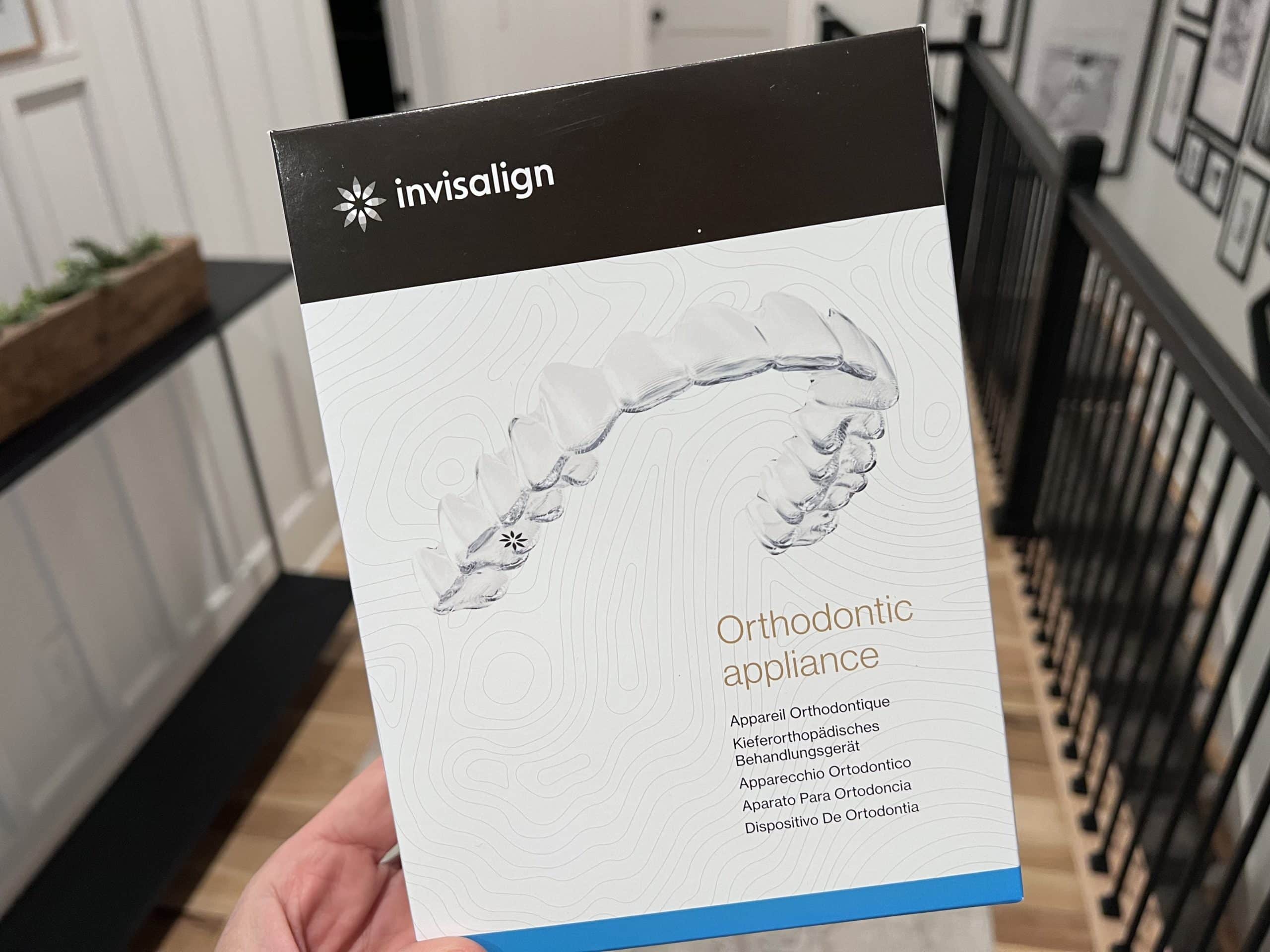Once upon a time, I found out my wife had braces when she was really young. Since she has such a beautiful smile, that made a ton of sense. However, this whole situation made me wonder how much braces might cost if all four of our kids wound up needing orthodontic care.
When we had this conversation, I initially joked that we would need to set up “braces savings accounts” for them instead of 529 college savings plans. That seemed really funny at the time, but this joke eventually turned into a financial reality.
When you actually do the math, traditional braces or Invisalign can easily cost $24,000 or more for four kids!
That’s not quite as much as a college education, but it’s still an expense that needs to be planned far in advance.
Braces vs. Invisalign
Not surprisingly, there are a lot more options today for orthodontic care than there were when my wife had braces 20+ years ago. Of course, orthodontists still use the same metal braces they have used all along. However, alternatives like Invisalign and Smile Direct Club are becoming more and more commonplace.
At first, these alternatives were primarily for adults who wanted to straighten their teeth without wearing traditional metal braces for a significant period of time. However, even children are experiencing the benefits of using clear aligners now, too.
The unique position I found myself in in terms of braces vs. Invisalign is the reason I am writing this guide. As a parent, I have experience paying for braces and Invisalign. Remember how I said I have four kids?
At this point, two of my sons have had traditional braces while my middle son had Invisalign. Below I share my experience with both as well as how costs broke down for each option.
Also check out my podcast on this topic:
What is Invisalign?
Invisalign is an orthodontic treatment that straightens teeth without the use of metal braces. Instead of using metal brackets and wire, Invisalign uses a series of clear plastic aligners that are virtually invisible when worn.
The aligners made by Invisalign are custom-made to fit each individual patient, and they gently shift teeth into the desired position over time just like braces do.
With that in mind, Invisalign is a great option for both adults and teens who are looking for a discreet way to achieve a straighter smile. Many people say this treatment is also more comfortable than traditional braces.
If you are considering orthodontic treatment, be sure to ask your doctor about Invisalign.
How is Invisalign Different from Braces?
As I already mentioned, Invisalign uses a series of aligners to gradually move teeth into their correct position instead of the metal brackets we all grew up with. Because the aligners are virtually invisible, many patients prefer Invisalign to braces.
Another factor that makes Invisalign different is the fact the aligners can be removed for eating, drinking, and brushing. This makes them much more comfortable and convenient than traditional braces. Overall, Invisalign is a more aesthetically pleasing and comfortable alternative to braces.
The braces many of us had growing up also move teeth into place, but they are permanently affixed to teeth from day one. This means your smile is permanently altered for the entire time you might have to wear braces, and that you have to take special care to brush and floss around braces for years on end.
How Invisalign Works
Here’s my experience with Invisalign and how it works, but remember that every orthodontist has a different process for administering Invisalign to their patients.
Our middle son was 11-years-old when he began receiving Invisalign treatment, and we were given three months of Invisalign packets to take home.
The packets we received look like this:
Each packet contained Invisalign retainers that were meant to last around two weeks. After using the first set of aligners for two weeks, you were supposed to discard them and move to the next packet.
Each packet was clearly marked so you could see which week you were on, and so you didn’t use the retainers in the wrong order.
Because of the way the Invisalign process works, my initial thought was that it might be risky for kids who aren’t super responsible. After all, it would be incredibly easy to misplace the Invisalign retainers or accidentally throw them away in the trash. This is especially true since the aligners are meant to be taken out of your mouth while you eat. I could definitely picture some kids taking out their aligner to eat lunch at school, then dumping their retainers in the trash with their lunch tray.
Our middle son getting Invisalign is very responsible, though. Due to his personality, we felt confident in letting him go through with Invisalign.
That said, it’s still not uncommon for me to go to his bedroom and find his Invisalign retainers sitting on his desk like this:
Also be aware that losing a set of Invisalign retainers may not be the end of the world. If your kid winds up misplacing an Invisalign retainer, your next steps really depend on where you were at in the process. If you are close enough to the end of one set, for example, you may be able to go ahead and begin the next packet.
If you’re not far enough along to wear the next set because your teeth haven’t adjusted enough, however, you’ll have to ask your orthodontist to re-order the aligner that was lost or misplaced.
Who is the Ideal Candidate for Invisalign? Who Should Get Braces Instead?
Generally speaking, patients who have mild to moderate crowding or spacing issues are good candidates for Invisalign. The treatment can also be used to correct overbites, underbites, and crossbites.
Dr. Christopher Fogarty, an orthodontist in Tullahoma, Tennessee, says that he typically recommends Invisalign to patients who have an open bite, or a situation where their top and bottom teeth don’t vertically overlap.
“I will recommend Invisalign because it does a great job of moving the back teeth in a way that helps fix the bite,” he says.
That said, he often recommends braces for other patients depending on the type of dental work they need.
According to Dr. Wes Chlandy, an orthodontist near Nashville, Tennessee, patients need to wear Invisalign aligners in the correct and compliant way in order to effectively straighten teeth, and many patients struggle to wear them correctly.
With that in mind, patients who are considering Invisalign need to be a good dental candidate and committed to wearing their aligners as directed by their orthodontist. In the meantime, patients must be prepared to clean their aligners regularly and take care of their teeth during treatment.
Another Nashville orthodontist named Dr. Brandon Foltz says that certain types of families may struggle more with Invisalign due to their schedules.
“I tend to find the busier the kids and families are, the more challenging keeping things on track with Invisalign trays can be,” he says.
Dr. Foltz explains that, for this reason, many kids and parents still tend to go with traditional braces.
However, he adds that adults often prefer Invisalign since it lets them straighten their teeth without many people noticing.
Ultimately, whether or not you’re a good fit for Invisalign will depend on your lifestyle and your dental needs. With proper care and compliance, though, Invisalign can give you a beautiful, straight smile.
Your orthodontist can evaluate your specific case and let you know if Invisalign is a good fit for you. Keep in mind that many of the orthodontists we spoke to for this story stressed the need for compliance when it comes to Invisalign.
Which is More Expensive: Invisalign or Braces?
If you’re wondering about the costs of Invisalign vs. braces, you should know that this depends on a range of factors. While Invisalign typically costs more than traditional braces, this isn’t always the case.
Ultimately, the final costs of either plan depend on the individual’s specific needs. If someone has a very complex dental issue that requires a lot of work, for example, Invisalign might actually be cheaper in the long run.
If someone with relatively straight teeth just needs a little bit of tweaking, braces will probably be the cheaper option.
With this in mind, you will likely want to ask your child’s orthodontist which option might cost more or less over the long run. After all, they will have a better idea of how much work your kid’s teeth require, and which option will be more efficient or affordable as a result.
Invisalign vs. Braces: Detailed Cost Comparison
As I mentioned already, all three of my sons have had their teeth straightened with professional orthodontic treatment. Where my oldest and youngest both went the traditional route with metal braces, my middle son had Invisalign.
This puts me in the unique position of knowing how much each option wound up costing our family, which I’ve detailed in the chart below.
| Type of Orthodontic Care | Which Kid? | Age | Cost |
| Metal Braces | Parker | 14 | $6,300 |
| Invisalign | Bentley | 12 | $6,300 |
| Metal Braces | Sloane | 10 | $3,460 |
This brings the total cost of braces or Invisalign for three kids to $16,060 — and I haven’t even gotten to my fourth child yet!
Average Costs for Different Types of Braces
According to Orthodontic Specialists, the cost of orthodontic care will ultimately depend on the patient’s age and the length of treatment. Many insurance plans can also help cover the cost of braces, so out-of-pocket costs will vary from person to person depending on whether or not they have dental insurance and what their coverage entails.
That said, here are some figures that show average costs for orthodontic care depending on the type of braces involved. The chart also highlights some basic information about each type of treatment, as well as the main pros and cons.
| Type | Cost | Info | Pros | Cons |
| Metal Braces | $3,000 – $5,000 | Most common; high-grade stainless steel bonded to the front of the teeth. | Very strong, can correct the most severe cases of misaligned teeth | More visible than other types of braces |
| Ceramic Braces | $4,00 0- $8,000 | Treatment that uses clear or tooth-colored brackets and wires to straighten teeth. | Less noticeable | Higher cost than traditional |
| Lingual Braces | $ 8,000 – $10,000 | Works the same as traditional braces, using brackets and wires to move teeth to the correct position. | They are virtually invisible | They are placed on the inside surface of the teeth and may be uncomfortable |
| Invisalign | $3,000 – $8,000 | Great alternative to traditional braces | Clear, plastic aligners are custom-made for your teeth. They are invisible and removable. | You must wear aligners for 20-22 hrs a day. |
Other Cost Considerations: Will You Need an Oral Surgeon?
As you take the time to compare Invisalign vs. braces, you should also ask your orthodontist whether other types of care may be required. As an example, my oldest son needed to have two teeth pulled in order to create space for his braces to work out.
Although he was only 14 at the time, his dental X-rays revealed that his wisdom teeth would eventually need to be extracted. Since he was already having two teeth pulled to prepare for his braces, we decided to have his wisdom teeth pulled at the same time.
Sounds miserable, right? Most people know that having their wisdom teeth pulled can be a living nightmare, but just imagine how it might feel to have two extra teeth pulled on the same day.
I felt so awful for my son after the procedure was over. It definitely worked and his teeth look amazing now, but he went through a painful ordeal to get there.
So, what’s the point? While the oral surgery my child went through wasn’t directly related to the cost of his braces, he had to have it to move to the next phase of his dental care. With that in mind, you’ll want to factor in any additional work your child will need before they can get braces.
Below you’ll find a copy of the statement of services for my kid’s oral surgery. If this bill isn’t frightening, I don’t know what is!
How Many Appointments are Required for Braces or Invisalign?
Generally speaking, patients wearing Invisalign often have fewer appointments with more spacing between visits compared to patients with braces. While this isn’t always the case, it typically works out this way since they continually progress through a series of corrective aligners they receive ahead of time for use at home.
According to Dr. Chlandy, in-office visits for Invisalign patients can also take less time overall.
“Many Invisalign treatments in my office now take less time than treatments with braces because most of my patients now change their aligners weekly,” he says.
Does Insurance Cover Invisalign?
Dental insurance plans don’t typically cover the full cost of Invisalign. However, you may be able to get some money back through your plan if your dentist or orthodontist files a claim on your behalf. Each plan is different, so it’s best to check with your insurer to see what might be covered.
Some companies also offer dental savings plans that can help offset the cost of Invisalign. These plans are not insurance, but they do offer discounts on a variety of dental services, including orthodontics.
If you’re considering Invisalign, be sure to ask your dentist or orthodontist about payment options and whether they offer any discounts. There are also a number of financing options available that can make Invisalign more affordable.
Be sure to shop around and compare rates before making a decision. With a little bit of research, you should be able to find a payment option that works for you.
Does Insurance Cover Braces?
Most insurance companies will cover at least a portion of the cost of traditional braces for children and teens. This is due to the fact that incorrect alignment of the teeth can lead to more serious problems later on, such as difficulty chewing or swallowing, TMJ, and even sleep apnea.
For adults, insurance coverage might be less common, but some policies will still provide some coverage for cosmetic reasons. Ultimately, it depends on the individual insurance plan.
Also note that some plans may have a lifetime limit for orthodontic coverage, while others may only cover a certain percentage of the total cost. It’s important to check with your insurance provider to find out what kind of coverage is available under your plan.
How to Pay for Braces or Invisalign
If insurance won’t cover the full cost of your orthodontic treatment, there are several different ways to pay for the care your child needs.
Cash
If you’re looking to save money on braces, one option is to pay cash upfront. Many orthodontists offer a discount for patients who pay in full, so this can be a great way to reduce your overall costs.
Of course, not everyone has the ability to pay for braces in cash. If you do have the funds available, however, it’s definitely worth considering. In addition to the discount, paying in cash can also help you avoid interest charges and other finance fees.
Financing
There are often several ways to finance orthodontic treatment, whether it’s through your orthodontist’s office, using a credit card, or taking out a personal loan. Check with your orthodontist’s office to see what kind of financing options they offer, but don’t be afraid to seek out your own financing as well.
For example, you may be able to finance braces with a 0% APR credit card that lets you make payments on your child’s braces interest-free for up to 21 months. The best personal loans can also help you finance braces or Invisalign with competitive interest rates and fixed monthly payments that will never change.
FSA
A flexible spending arrangement (FSA) is a special account you can put money into that lets you use pretax dollars to pay for certain medical expenses. The money that is put into an FSA is deducted from an individual’s paycheck, and it can be used to pay for things like co-pays, prescriptions, and dental care.
One of the benefits of an FSA is that it can help people save money on taxes. Another benefit is the fact this account helps people budget for medical expenses. If someone knows that they will have to pay a $100 copay for a doctor’s visit, for example, they can put $100 into their FSA so that they will have the money when they need it.
FSAs are a great way for people to save money on their healthcare costs, but not everyone has access since these accounts are offered by employers.
HSA
A Health Savings Account (HSA) is a type of savings account that can be used to cover medical expenses. HSAs are available to people who have a high-deductible health insurance plan. Money contributed to an HSA is not subject to federal income tax, and withdrawals from the account can be used to pay for qualified medical expenses tax-free.
Opening a HSA is a great way to save money on healthcare costs, and for more reasons than one. The money you contribute to your HSA can be used to pay for things like deductibles, co-pays, and other out-of-pocket costs. And, because the money in your HSA grows tax-free, it can really add up over time.
If you’re considering an HSA, be sure to check with your health insurance provider to see if you’re eligible. And, make sure you understand the rules about how much you can contribute and what kinds of expenses are covered. With a little planning, a HSA can help you save money on healthcare costs and dental care.
Alternatives to Invisalign and Braces
Not sure if Invisalign or braces are right for you? In that case, you can also check out Smile Direct Club.
Smile Direct Club is another company that provides clear aligners to straighten teeth. The company was founded in 2014, and it had served over 1.5 million customers in the United States as of 2022.
Smile Direct Club operates online and through a network of physical locations, and customers can start the process by scheduling an appointment at a SmileShop or taking a free online assessment. Once the customer’s smile has been assessed, a treatment plan is created and the aligners are shipped directly to their home.
| Invisalign | SmileDirect club | Clear Correct |
| Clear Aligner | Clear aligner | Clear aligner |
| Cost $3,000-$7,000 | Cost $2,000+ | Cost $2,000-$8,000 |
| Requires a dental visit and follow-up appointments | No dental visit or follow-up appointments. | Requires a dental visit and follow-up appointments |
As you can see in the chart above, Smile Direct Club is more affordable than braces or Invisalign. As of this moment, they also offer a monthly payment plan for $89 per month for 26 months with a $250 deposit. You can also make a single payment of $2,050.
They also offer benefits for teenage customers such as video chats and treatment notifications parents can access.
Because of the lower price and accessibility of remote treatment, Smile Direct Club is another option parents should consider for their children’s orthodontic needs.
Invisalign vs. Braces Frequently Asked Questions (FAQ)
Traditional braces are still just popular as ever, with an estimated 4 million people in the United States wearing them. Metal braces are the most common type of braces, and they typically cost between $3,000 and $7,000. Ceramic braces are less visible than metal braces and cost between $4,000 and $8,000.
Invisalign is a popular alternative to braces that uses clear plastic aligners to gradually straighten teeth. Invisalign can cost between $4,000 and $8,000. Most orthodontists offer payment plans that allow patients to spread out the cost of Invisalign over several years.
Most people wear braces for about two years, although the exact amount of time depends on the individual and their treatment plan. Metal braces are the most common type of braces, and they are usually made from stainless steel or titanium. Clear braces are another option that are becoming increasingly popular, but they may require more time to achieve the same results.
The average treatment time for Invisalign is about 12 months, although the treatment timeline can vary depending on the individual.
Braces are typically more affordable than Invisalign, and they can be used to treat a wide range of dental problems. However, braces can be uncomfortable and they require regular adjustments. Kids with traditional braces are also stuck with metal in their mouths for years on end.
Invisalign, on the other hand, is much more comfortable to wear and does not require any adjustments. Invisalign is also less visible than metal braces, making it a good choice for adults who are concerned about their appearance.
Ultimately, the decision between braces and Invisalign comes down to personal preference. As you can tell from my own personal experience, I have chosen to go with both options for my own kids for different reasons.
If you don’t want permanent brackets on your teeth, then Invisalign is completely worth it! But it also depends on your budget and what you are trying to accomplish. Here are some things to consider:
Effectiveness: Invisalign is generally effective at straightening teeth, although the severity of your misalignment will determine how well it works. In some cases, traditional braces may be more effective at achieving certain types of tooth movements. Your orthodontist can help you determine the best treatment option for your needs.
Cost: Invisalign is generally more expensive than traditional braces. The cost of treatment will depend on the complexity of your case and the length of treatment. Some dental insurance plans cover a portion of the cost of orthodontic treatment, including Invisalign.
Comfort: Many people find Invisalign to be more comfortable than traditional braces, as they do not have any metal wires or brackets. The aligners are made of a smooth, comfortable material and are custom-fit to your teeth.
Convenience: Invisalign aligners are removable, which means you can take them out to eat and brush your teeth. This can be more convenient than dealing with the food restrictions and extra oral hygiene steps that are required with traditional braces.
Overall, Invisalign can be a good option for people who want to straighten their teeth discreetly and comfortably, and who are willing to pay the higher cost. However, traditional braces may be a better option for people with more severe misalignment or for those who are looking for the most cost-effective treatment. It’s important to consult with an orthodontist to determine the best treatment option for your individual needs.



